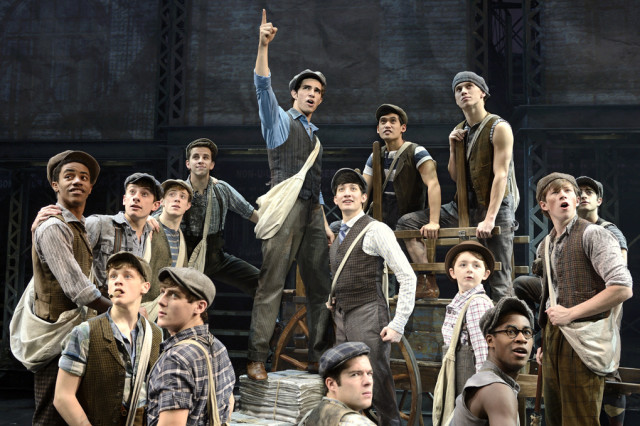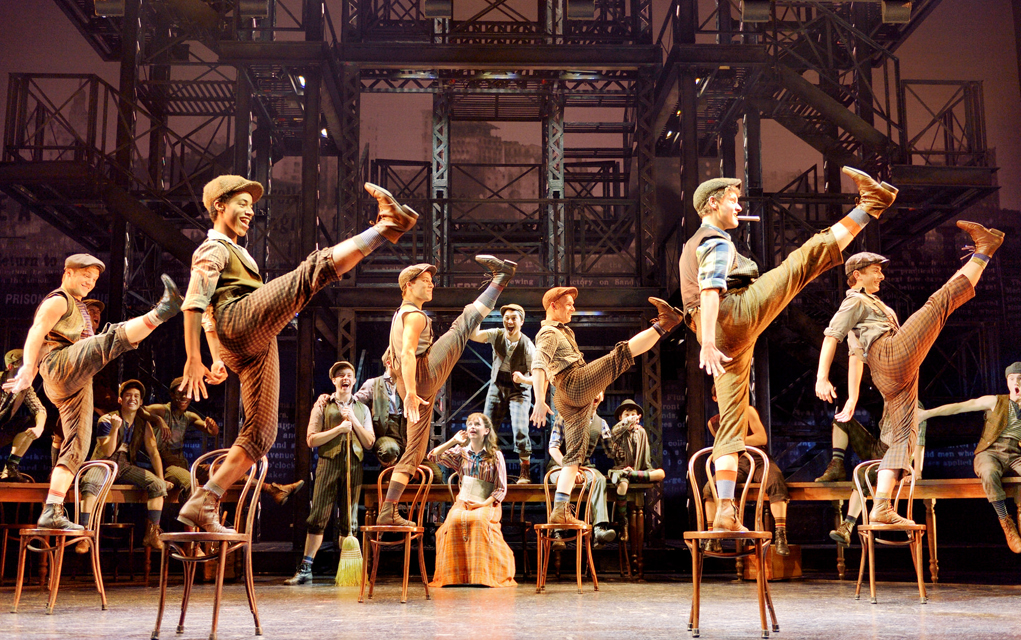
“Just because we only make pennies don’t give anyone the right to up and rub our noses in it,” says a frustrated newsboy in the musical Newsies. When a few cents is the difference between life and death for these boys on the streets, revolution starts brewing in an epic battle against The Man.
Disney’s Broadway production of Newsies, now playing at the Buell Theater in Denver through April 9, follows the story of New York City newsboys striking unfair price hikes that cut into their earnings at the turn of the 20th century.
The show is based on the true story of strikers seeking fair compensation for their work from newspaper giants Joseph Pulitzer and William Randolph Hearst in 1899. The strike, which lasted nearly two weeks, halted newspaper circulation throughout the city and all of New England as more than 5,000 children demonstrated across the Brooklyn Bridge, stopping traffic for several days.
It’s a story that resonates just as much today as it did more than a century ago as both employers and employees are faced with an ever-widening wage gap that has caused strikes across industries in recent years, from teachers to fast food workers. And it’s this inequality that has become a major driving force of the current presidential election, as candidates and voters on both sides of the spectrum debate this issue. This makes Newsies all the more relevant as perhaps there’s no better metaphor for the disenfranchised than orphaned children banding together as they fight to survive.
The demonstrated power of the collective voice is Newsies’ main strength, and the musical is driven by songs and dance numbers performed by an incredibly talented chorus. Lyrics such as “Wrongs will be righted/ If we’re united/ Let us seize the day,” are intertwined with different dance styles such as ballet, jazz and tumbling to create cohesive and powerful numbers that leave the audience cheering. Mixed with a dynamic (and Tony-award nominated) set design that aptly captures the bustling city life of New York, these ensemble performances steal the show.

But the real show-stopping moment came after intermission in act two’s opening number, “King of New York.” The previous day, newsies were both and arrested as newspaper henchman and police broke up the first day of the strike. But the newsies taste their first bite of success as this initial strike makes front page news, even as many of them sport black eyes and injuries. The boys grow increasingly excited and justified about their perceived fame, breaking into a spirited tap dancing scene that had the crowd clapping along. This momentum-building number carries the second half of the show, as the boys continue in their fight to be heard by their employers. It’s this crowd-pleasing dancing that won choreographer Christopher Gattelli a Tony Award in 2012.
While the chorus is the strength of the show, like any good story, Newsies also finds its hero in the single character of Jack Kelly. And it’s in the character of Jack that we can relate to the story on an individual level as he struggles with an internal conflict we all face — between individuality and community, balancing our own self-interests and the interests of others.
As Jack wrestles with his own needs and dreams, as well as his insecurities, he finds himself, for a brief moment, at odds with the community around him. Individualism entices Jack, causing him to retreat and isolate himself from the others, telling him he’s better off by himself. That is until he realizes these boys aren’t simply friends, but family, and the impossibilities he faces alone are achievable if he relies on others.
The boys soon become a galvanizing force throughout the entire city. Joined by the feisty and ambitious journalist Katherine Plumber, together they, “Challenge a whole generation to stand up and take a place at the table,” — a message young voters need to be reminded of in this election year. The strike eventually entices not only newsboys from other boroughs but all child workers across industries, as Jack and friends successfully negotiate a fair compensation with Pulitzer.
It’s shows like Newsies that give us hope; that show us the strength of a united community; that remind us that throughout history, change has come as people stand together in the face of injustice. And that change, more often than not, comes as the established authorities make room for the voice of the younger generation.
“Each generation must, at the height of its power, step aside and invite the young to share the day,” says New York governor Teddy Roosevelt in a cameo during the closing scene. “You (newsies) have laid claim to our world, and I believe the future, in your hands, will be bright and prosperous.”














